The featured image above is a dramatic representation used for awareness. Actual mold in our home has been professionally documented and may differ in appearance.
🔍 Quick Summary – What You’ll Learn in This Post:
- Mold confirmed in both the attic and indoor air of our home
- Multiple violations of the 2020 Florida Building Code uncovered
- No roof exhaust vents installed—attic cannot properly ventilate
- Improper duct insulation used: R-6 instead of the required R-8
- ⚠️ A checklist of what every Neal Communities homeowner should inspect right now
What’s Hiding in Your Attic?
Why Every Neal Communities Homeowner Should Care About Their HVAC System and Attic Conditions
If you’re already living in a Neal Communities home, chances are you’ve focused your energy on settling in—enjoying your new kitchen, organizing your garage, decorating your lanai. But there’s one part of your house you probably haven’t thought much about: the attic.
And that’s exactly where the trouble hides.
We were just like you. Proud of our new home. Trusting the name, Neal Communities, behind it. Until we started noticing very high humidity, inconsistent cooling, and signs of moisture and mold on our HVAC vents. What we discovered next shocked us—and in our opinion, it could be happening in other Neal Communities homes.
The attic houses our HVAC system, the lungs of our home. If it’s not built right—or up to code—we’re breathing in the consequences.
Mold, Moisture, and Code Violations: Our Reality
We had airborne mold confirmed inside our home. The same type—Penicillium-Aspergillus—was found in our attic. How? Because of HVAC and design problems that, according to our inspector and structural engineer, violate Florida Building Code.
❄️ Code Violation #1: Improper Duct Insulation (R-6 instead of R-8)
When we had our HVAC system and attic professionally inspected, one of the first red flags we discovered was the insulation rating on our HVAC ductwork. It was installed with R-6 insulation—but according to the 2020 Florida Building Code, Energy Conservation Section R403.3.1, any ductwork located in unconditioned spaces like the attic is required to be insulated to at least R-8.
💡 What Does “R-Value” Mean?
R-value is a measure of how well insulation resists heat flow. The higher the number, the better it performs.
In a brutally hot Florida attic, the wrong R-value allows hot air to surround your ducts—and when those cold air ducts come in contact with that heat, condensation forms.
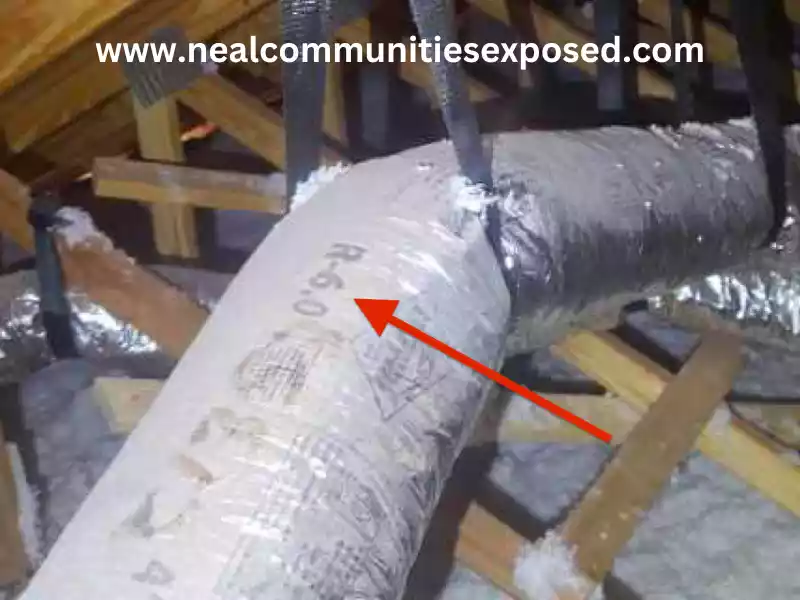

Why it matters:
- R-value measures thermal resistance. R-6 lets more heat in.
- Hot attic air + cold ducts = condensation.
- Condensation = mold.
Result in our Neal Communities Home:
- Sweating ducts
- Wet insulation
- Mold on ducts and attic floorboard
- Increased HVAC strain and higher energy bills
📜 2020 Florida Building Code R403.3.1 Insulation (Prescriptive)

👉 Link to 2020 Florida Building Code R403.3.1
💨 Code Violation #2: No Exhaust Vents in the Roof
According to our structural engineering report, and the home inspection report, our attic was constructed without any form of exhaust vents—only soffit vents, which are designed for intake only. According to the 2020 Florida Building Code R806.1 and R806.2, balanced attic ventilation is required. That means soffit vents (intake) must be paired with exhaust vents (like ridge vents, gable vents, or roof-mounted vents) to allow air to flow properly in and out of the attic.
Our attic has NO ridge, gable, or roof-mounted vents.
Why it matters:
- No air out = trapped heat and humidity
- HVAC ducts are exposed to extreme temps
- Condensation builds—then mold follows
📜 What our Experts say:
Our hired Structural Engineer:


Our Master Home Inspector:


2020 Florida Building Code Violations
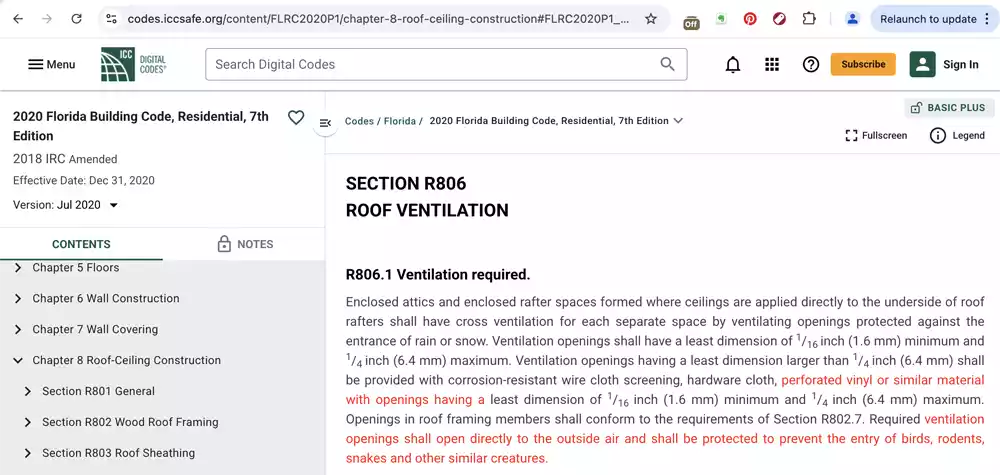

👉 Link to 2020 Florida Building Code R806.1 Ventilation required
👉 Link to 2020 Florida Building Code R806.2 Minimum vent area
In our home, according to our reports, this design flaw directly contributed to the growth of mold in the attic—and eventually inside our living space.
💧 Sweating Ducts: The Warning Sign You Can’t Ignore
In a properly built home, the HVAC system should regulate temperature and humidity—not create moisture problems. But in our case, that’s exactly what happened. The ductwork in our attic began to sweat heavily, and what followed was exactly what you’d expect: wet insulation, moisture damage, and eventually, mold.
💧 What Causes Duct Sweating?
When hot, stagnant attic air surrounds under-insulated ducts, it causes duct sweating. That condensation drips onto insulation and framing and then breeds mold.
🔎 What We Found in Our Attic:
- R-6 insulation (should be R-8)
- No roof exhaust vents
- Kinked, sagging, and bent ducts
- Zip ties instead of proper supports
- Ducts touching other ducts
This isn’t minor. This is a failure in basic installation practices.
Kinked, Bent, and Sagging Ducts
If supply or return ducts are kinked, undersized, or poorly installed, airflow is compromised. That means humid air may not be properly circulated, leading to stagnant, moist conditions in the system and surrounding spaces.
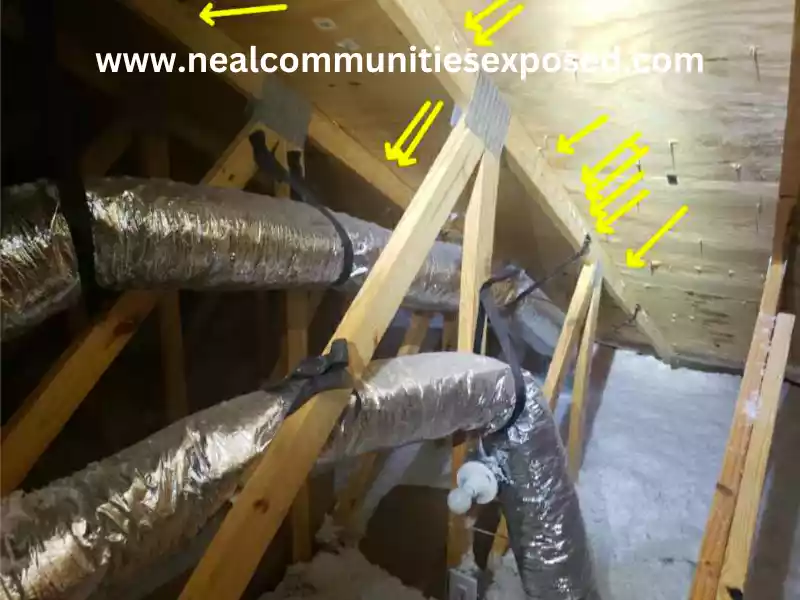
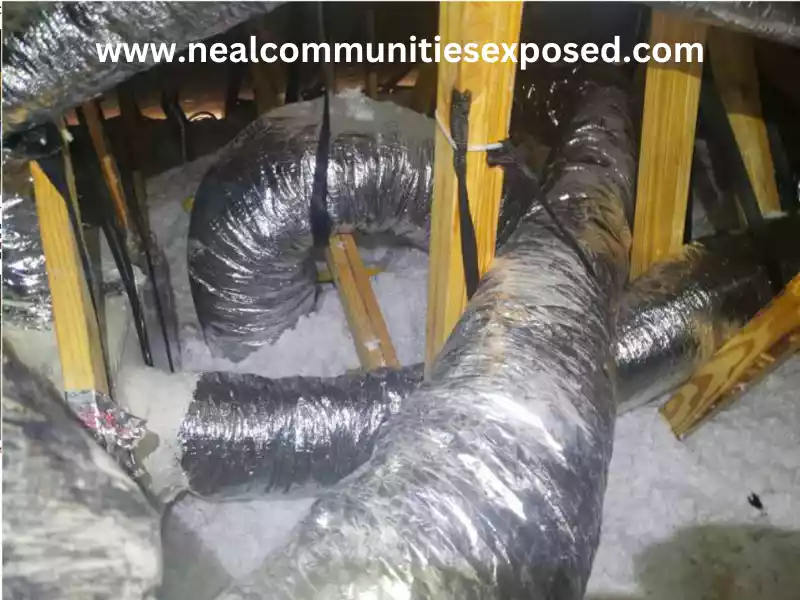

Zip ties instead of proper strapping
Using zip ties instead of proper duct strapping isn’t just unprofessional—it creates real moisture risks.
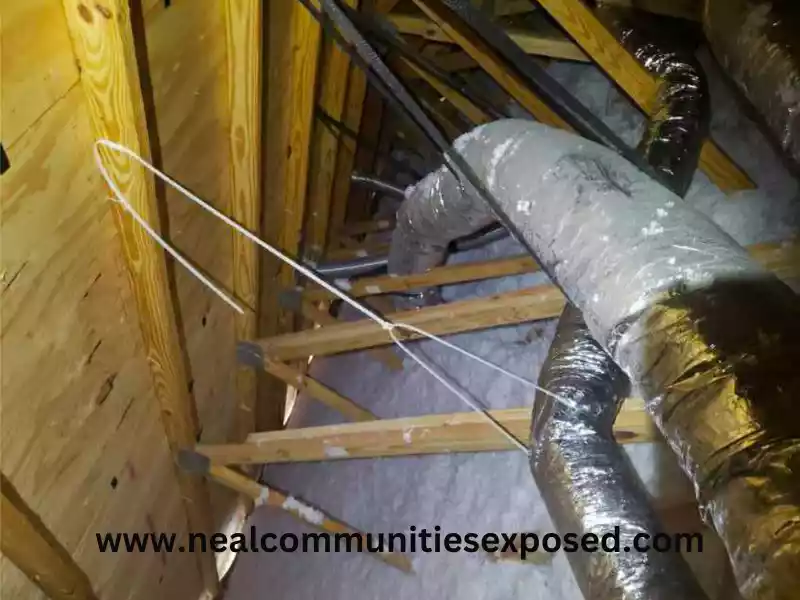
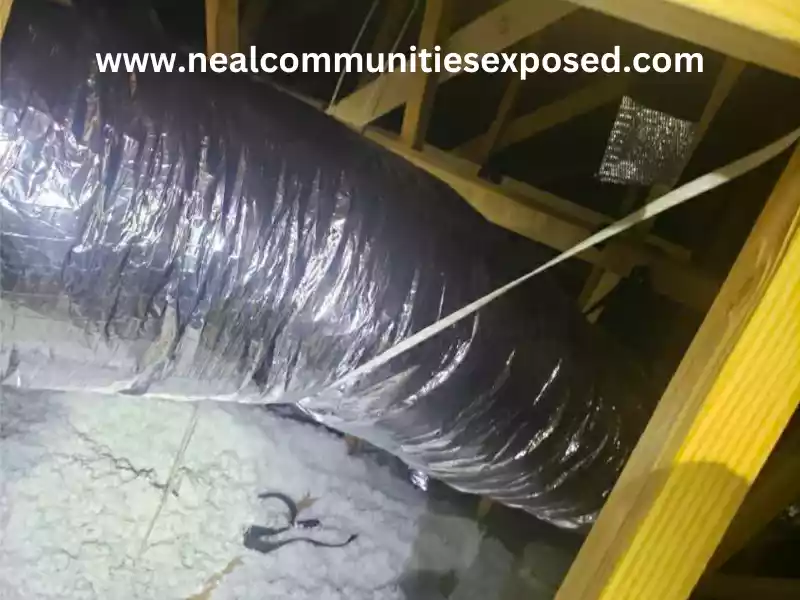
Duct touching other Ducts
When air conditioning ducts are in contact with each other—or with other duct types like exhaust ducts—it traps cold surfaces together, leading to condensation between them. This violates Florida Building Code FBC 603.12, which clearly states that provisions must be made to prevent condensation on the exterior of any duct. In our attic, AC ducts are visibly resting against each other and in contact with exhaust ducts, creating condensation points that drip onto insulation and framing—a direct path to mold and moisture damage.
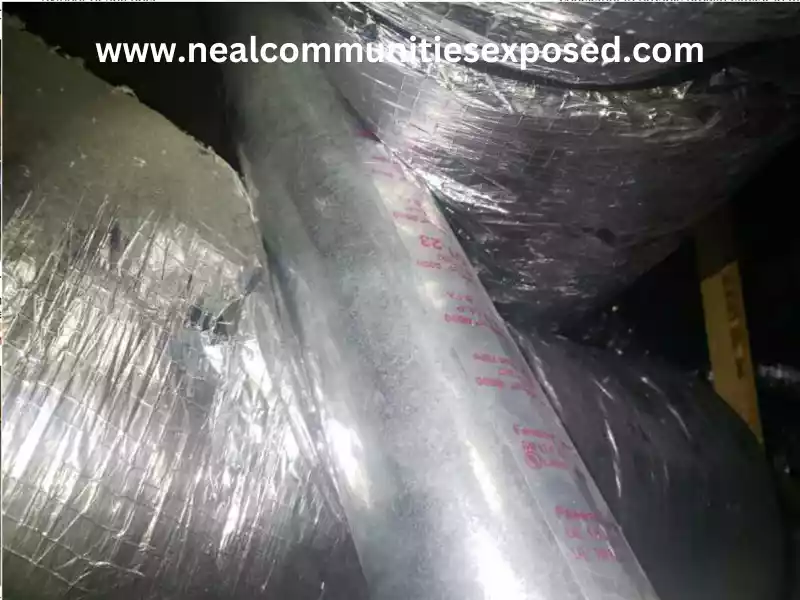
2020 Florida Building Code Violations
Supports

👉 Link to 2020 Florida Building Code, Mechanical, 7th Edition, 603.10 Supports
👉 Link to 2020 SMACNA
Condensation

👉 Link to 2020 Florida Building Code, Mechanical, 7th Edition, 603.12 Condensation
Neal Communities failed to meet that standard in our home, and we’re now living with the result—a contaminated HVAC system and a persistent humidity problem.
🧪 Airborne Mold Confirmed
We didn’t imagine it. We tested. And the results were undeniable.
Professional air quality testing confirmed widespread airborne mold inside our home.
Further sampling found the same species—Penicillium-Aspergillus—present in both our attic and our living spaces.
This wasn’t surface-level dust. This was mold in the air we breathe, circulating through our HVAC system—originating in a space we trusted was built correctly
We’ll be publishing a full breakdown of this mold species and the risks it poses, especially to children, seniors, and those with allergies or asthma. But here’s what you need to know right now:
We didn’t build this. Neal Communities did.
And according to multiple licensed experts, what’s in our attic does not meet code.
This isn’t just a construction flaw. This is a health hazard—and it was built into the home we were supposed to feel safe in.
💥 Why This Should Terrify Every Neal Homeowner
If you live in a Neal Communities home and your HVAC system is in the attic—pay attention.
What you need to do:
🔎 Look at your duct insulation:
- Find the R-value tag on your ductwork.
- If it says R-6, that’s not compliant with the 2020 Florida Building Code, which requires
- R-8 in unconditioned spaces like attics.
🔎 Check your roof for exhaust ventilation:
- According to Experts and the Florida Building Code, soffit vents alone are not enough.
- Your attic should have ridge vents, gable vents, or roof-mounted exhaust vents.
- If you don’t see any, your attic isn’t breathing—and that means moisture may be building up.
🔎 Inspect your ductwork for signs of trouble:
- Is the ductwork sweating or dripping?
- Are the ducts sagging, touching each other, or strapped with zip ties instead of proper supports?
- Is the insulation beneath the ducts damp or discolored?
- Do you have signs of moisture or mold damage on your ceiling?
🔎 Monitor the humidity inside your home!
Persistent high humidity isn’t just uncomfortable—it’s a red flag.
It can be a silent warning that something is wrong above the ceiling.
Since launching this blog and connecting with many other homeowners, we’ve learned that we’re not alone—not even close. Multiple Neal Communities homeowners have reported similar issues. Some are even facing conditions more severe than what we discovered.
You paid for a safe, properly constructed, code-compliant home.
Now it’s up to you to make sure that’s what you actually received.
In our case, we believe Neal Communities cut corners.
According to our experts, Neal Communities didn’t follow the Florida Building Code, and now we’re living with the consequences—every single day.
💔 This Should Never Happen in Any Home
Let’s be clear.
- We bought a brand-new home.
- From a well-known builder.
- In good faith.
- With trust.
- With pride.
And what did we get?
- Mold.
- Humidity.
- Condensation.
- Non-code-compliant duct installation.
- Not properly vented attic spaces.
- Building code violations confirmed by licensed professionals.
And worst of all—a house we no longer feel safe living in.
- This wasn’t some freak accident or a rare exception.
- This wasn’t due to homeowner neglect.
- This was built this way. From the ground up. By Neal Communities.
We didn’t ask for perfect. We asked for code-compliant, livable, and safe. What we got is a health risk hiding behind drywall and ductwork.
That’s why we are here to say:
- This is not normal. This is not okay. And this is not what a “quality builder” delivers.
- We are emotionally exhausted.
- We are devastated—because no family should have to go through this in a brand-new home.
- No one should fear what they’re breathing.
- No one should have to test their air just to feel safe in their own living room.
- No one should discover mold growing above their ceiling.
- And no homeowner should be ignored by their builder for six months—with zero repairs undertaken.
This should never happen in any home. Ever.
- And yet—it happened to us.
- And if you’re living in a Neal Communities home, you deserve to know: it might be happening to you too.
- We’re not staying quiet.
- We’re not covering this up to protect a builder’s brand.
- We are telling the truth—backed by photos, inspections, engineering reports, and testing.
Because someone has to.
- We hope you never have to go through what we’ve endured.
- But if you are? You are not alone. And we’re going to make sure this story is heard.
Thank you to everyone who has reached out, shared their own stories, or simply offered a few kind words. Your support means more than we can express.
We’ve been overwhelmed—in the best way—by the messages, the solidarity, and the strength of this growing community. Every comment, every share, every voice is helping us bring the truth to light.
Join the Movement – Stay Informed, Stay Connected
Our story is still unfolding, and we are committed to fighting until justice is served. Homeowners deserve transparency, accountability, and the quality they were promised. By sharing our experience, we hope to provide valuable insight, raise awareness, and ensure that no one else has to navigate these challenges alone.
If you own a Neal Communities home, we encourage you to follow our Facebook Page and join our private Facebook Group, where homeowners can connect, support each other, share their experiences, and learn how to advocate for their rights.
For updates, behind-the-scenes insights, and real-time content, and to follow how this fight continues, be sure to follow us on:
📌 Facebook Page: https://www.facebook.com/nealcommunitiesnightmare Follow for Updates on our Journey!
📌 Facebook Group for Neal Communities Home Owners: https://www.facebook.com/groups/nealhomeowners
📌 Instagram: https://www.instagram.com/nealnightmare/
📌 TikTok: https://www.tiktok.com/@nealnightmare
📌 X (Twitter): https://x.com/NealExposed
📌 Pinterest: https://www.pinterest.com/nealexposed/
📌 Youtube: https://www.youtube.com/@NealCommunitiesExposed
📌 And more channels coming soon!
Every like, share, and comment helps spread awareness. Together, we can hold builders accountable and fight for the homes we deserve.
From the bottom of our hearts, thank you.
With gratitude and determination,
Zane & Svenya
Coming Soon:
- 🔬 Penicillium-Aspergillus Mold in Our Neal Communities Home – What This Mold Means for Your Health
- 🧾 What is a Chapter 558 Notice and What You Should Know About it
- 🏠 The Importance of Roof Sheathing and how to check if your Roof is Code Compliant
- 📣 What to Do If You Suspect Code Violations in Your Home
*) Featured image is a dramatic representation used for awareness. Actual mold in our home has been professionally documented and may differ in appearance.


